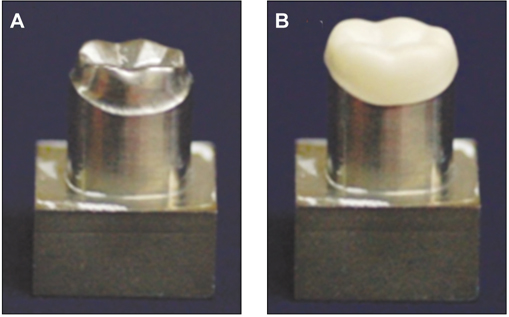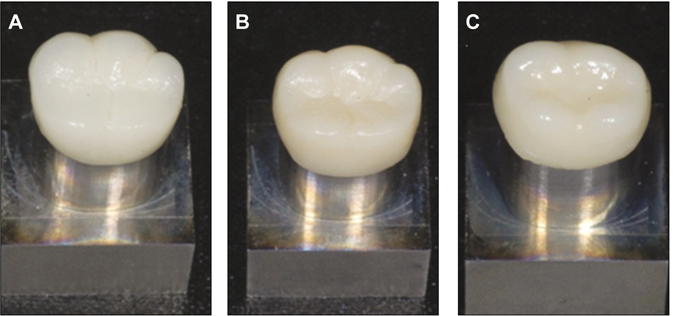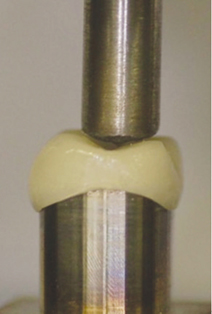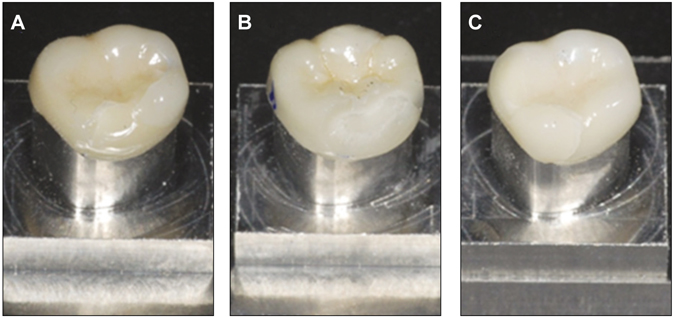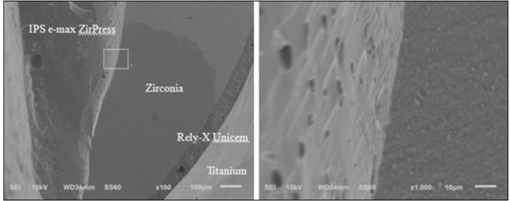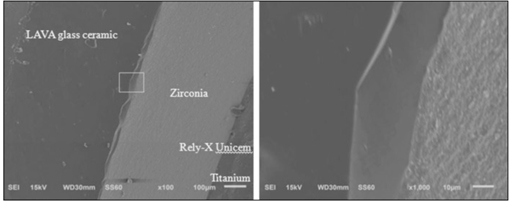J Adv Prosthodont.
2012 Aug;4(3):162-169. 10.4047/jap.2012.4.3.162.
In vitro evaluation of fracture strength of zirconia restoration veneered with various ceramic materials
- Affiliations
-
- 1Department of Prosthodontics and Dental Research Institute, School of Dentistry, Seoul National University, Seoul, Korea. ksh1250@snu.ac.kr
- KMID: 2176412
- DOI: http://doi.org/10.4047/jap.2012.4.3.162
Abstract
- PURPOSE
Fracture of the veneering material of zirconia restorations frequently occurs in clinical situations. The purpose of this in vitro study was to compare the fracture strengths of zirconia crowns veneered with various ceramic materials by various techniques.
MATERIALS AND METHODS
A 1.2 mm, 360degrees chamfer preparation and occlusal reduction of 2 mm were performed on a first mandibular molar, and 45 model dies were fabricated in a titanium alloy by CAD/CAM system. Forty-five zirconia copings were fabricated and divided into three groups. In the first group (LT) zirconia copings were veneered with feldspathic porcelain by the layering technique. In the second group (HT) the glass ceramic was heat-pressed on the zirconia coping, and for the third group (ST) a CAD/CAM-fabricated high-strength anatomically shaped veneering cap was sintered onto the zirconia coping. All crowns were cemented onto their titanium dies with Rely X(TM) Unicem (3M ESPE) and loaded with a universal testing machine (Instron 5583) until failure. The mean fracture values were compared by an one-way ANOVA and a multiple comparison post-hoc test (alpha=0.05). Scanning electron microscope was used to investigate the fractured interface.
RESULTS
Mean fracture load and standard deviation was 4263.8+/-1110.8 N for Group LT, 5070.8+/-1016.4 for Group HT and 6242.0+/-1759.5 N for Group ST. The values of Group ST were significantly higher than those of the other groups.
CONCLUSION
Zirconia crowns veneered with CAD/CAM generated glass ceramics by the sintering technique are superior to those veneered with feldspathic porcelain by the layering technique or veneered with glass ceramics by the heat-pressing technique in terms of fracture strength.
Keyword
MeSH Terms
Figure
Reference
-
1. Barnfather KD, Brunton PA. Restoration of the upper dental arch using Lava all-ceramic crown and bridgework. Br Dent J. 2007. 202:731–735.2. Coli P, Karlsson S. Precision of a CAD/CAM technique for the production of zirconium dioxide copings. Int J Prosthodont. 2004. 17:577–580.3. Della Bona A, Mecholsky JJ Jr, Anusavice KJ. Fracture behavior of lithia disilicate- and leucite-based ceramics. Dent Mater. 2004. 20:956–962.4. Devaud V. Guidelines for success with zirconia ceramics: the changing standards. Pract Proced Aesthet Dent. 2005. 17:508. 510.5. Raigrodski AJ. All-ceramic full-coverage restorations: concepts and guidelines for material selection. Pract Proced Aesthet Dent. 2005. 17:249–256.6. Beuer F, Schweiger J, Edelhoff D. Digital dentistry: an overview of recent developments for CAD/CAM generated restorations. Br Dent J. 2008. 204:505–511.7. Luthardt RG, Holzhüter MS, Rudolph H, Herold V, Walter MH. CAD/CAM-machining effects on Y-TZP zirconia. Dent Mater. 2004. 20:655–662.8. Tinschert J, Natt G, Hassenpflug S, Spiekermann H. Status of current CAD/CAM technology in dental medicine. Int J Comput Dent. 2004. 7:25–45.9. Tinschert J, Natt G, Mautsch W, Augthun M, Spiekermann H. Fracture resistance of lithium disilicate-, alumina-, and zirconia-based three-unit fixed partial dentures: a laboratory study. Int J Prosthodont. 2001. 14:231–238.10. Vult von Steyern P, Ebbesson S, Holmgren J, Haag P, Nilner K. Fracture strength of two oxide ceramic crown systems after cyclic pre-loading and thermocycling. J Oral Rehabil. 2006. 33:682–689.11. Tinschert J, Zwez D, Marx R, Anusavice KJ. Structural reliability of alumina-, feldspar-, leucite-, mica- and zirconia-based ceramics. J Dent. 2000. 28:529–535.12. International Organization for standardization. ISO 6872:2008. Dental ceramic. 2008. Genova: ISO.13. Aboushelib MN, de Jager N, Kleverlaan CJ, Feilzer AJ. Microtensile bond strength of different components of core veneered all-ceramic restorations. Dent Mater. 2005. 21:984–991.14. Aboushelib MN, Kleverlaan CJ, Feilzer AJ. Microtensile bond strength of different components of core veneered all-ceramic restorations. Part II: Zirconia veneering ceramics. Dent Mater. 2006. 22:857–863.15. Beuer F, Edelhoff D, Gernet W, Sorensen JA. Three-year clinical prospective evaluation of zirconia-based posterior fixed dental prostheses (FDPs). Clin Oral Investig. 2009. 13:445–451.16. Sailer I, Fehér A, Filser F, Lüthy H, Gauckler LJ, Schärer P, Franz Hämmerle CH. Prospective clinical study of zirconia posterior fixed partial dentures: 3-year follow-up. Quintessence Int. 2006. 37:685–693.17. Vult von Steyern P, Carlson P, Nilner K. All-ceramic fixed partial dentures designed according to the DC-Zirkon technique. A 2-year clinical study. J Oral Rehabil. 2005. 32:180–187.18. Strub JR, Stiffler S, Schärer P. Causes of failure following oral rehabilitation: biological versus technical factors. Quintessence Int. 1988. 19:215–222.19. Bindl A, Lüthy H, Mörmann WH. Strength and fracture pattern of monolithic CAD/CAM-generated posterior crowns. Dent Mater. 2006. 22:29–36.20. Bindl A, Lüthy H, Mörmann WH. Thin-wall ceramic CAD/CAM crown copings: strength and fracture pattern. J Oral Rehabil. 2006. 33:520–528.21. Bindl A, Mörmann WH. Survival rate of mono-ceramic and ceramic-core CAD/CAM-generated anterior crowns over 2-5 years. Eur J Oral Sci. 2004. 112:197–204.22. Tinschert J, Natt G, Mohrbotter N, Spiekermann H, Schulze KA. Lifetime of alumina- and zirconia ceramics used for crown and bridge restorations. J Biomed Mater Res B Appl Biomater. 2007. 80:317–321.23. Witkowski S, Komine F, Gerds T. Marginal accuracy of titanium copings fabricated by casting and CAD/CAM techniques. J Prosthet Dent. 2006. 96:47–52.24. Proussaefs P. Crowns cemented on crown preparations lacking geometric resistance form. Part II: effect of cement. J Prosthodont. 2004. 13:36–41.25. Smith TB, Kelly JR, Tesk JA. In vitro fracture behavior of ceramic and metal-ceramic restorations. J Prosthodont. 1994. 3:138–144.26. Sundh A, Molin M, Sjögren G. Fracture resistance of yttrium oxide partially-stabilized zirconia all-ceramic bridges after veneering and mechanical fatigue testing. Dent Mater. 2005. 21:476–482.27. Potiket N, Chiche G, Finger IM. In vitro fracture strength of teeth restored with different all-ceramic crown systems. J Prosthet Dent. 2004. 92:491–495.28. Komine F, Blatz MB, Matsumura H. Current status of zirconia-based fixed restorations. J Oral Sci. 2010. 52:531–539.29. Preis V, Behr M, Hahnel S, Handel G, Rosentritt M. In vitro failure and fracture resistance of veneered and full-contour zirconia restorations. J Dent. 2012. 07. 24. [Epub ahead of print].30. Beuer F, Schweiger J, Eichberger M, Kappert HF, Gernet W, Edelhoff D. High-strength CAD/CAM-fabricated veneering material sintered to zirconia copings-a new fabrication mode for all-ceramic restorations. Dent Mater. 2009. 25:121–128.31. Scherrer SS, de Rijk WG. The fracture resistance of all-ceramic crowns on supporting structures with different elastic moduli. Int J Prosthodont. 1993. 6:462–467.32. Rosentritt M, Plein T, Kolbeck C, Behr M, Handel G. In vitro fracture force and marginal adaptation of ceramic crowns fixed on natural and artificial teeth. Int J Prosthodont. 2000. 13:387–391.33. Kelly JR. Clinically relevant approach to failure testing of all-ceramic restorations. J Prosthet Dent. 1999. 81:652–661.34. Ritter JE. Predicting lifetimes of materials and material structures. Dent Mater. 1995. 11:142–146.35. Tsalouchou E, Cattell MJ, Knowles JC, Pittayachawan P, McDonald A. Fatigue and fracture properties of yttria partially stabilized zirconia crown systems. Dent Mater. 2008. 24:308–318.36. Kelly JR, Tesk JA, Sorensen JA. Failure of all-ceramic fixed partial dentures in vitro and in vivo: analysis and modeling. J Dent Res. 1995. 74:1253–1258.37. Raigrodski AJ, Chiche GJ, Potiket N, Hochstedler JL, Mohamed SE, Billiot S, Mercante DE. The efficacy of posterior three-unit zirconium-oxide-based ceramic fixed partial dental prostheses: a prospective clinical pilot study. J Prosthet Dent. 2006. 96:237–244.38. Sailer I, Fehér A, Filser F, Gauckler LJ, Lüthy H, Hämmerle CH. Five-year clinical results of zirconia frameworks for posterior fixed partial dentures. Int J Prosthodont. 2007. 20:383–388.39. Snyder MD, Hogg KD. Load-to-fracture value of different all-ceramic crown systems. J Contemp Dent Pract. 2005. 6:54–63.40. Beuer F, Stimmelmayr M, Gueth JF, Edelhoff D, Naumann M. In vitro performance of full-contour zirconia single crowns. Dent Mater. 2012. 28:449–456.41. Pak HS, Han JS, Lee JB, Kim SH, Yang JH. Influence of porcelain veneering on the marginal fit of Digident and Lava CAD/CAM zirconia ceramic crowns. J Adv Prosthodont. 2010. 2:33–38.42. Bachhav VC, Aras MA. The effect of ceramic thickness and number of firings on the color of a zirconium oxide based all ceramic system fabricated using CAD/CAM technology. J Adv Prosthodont. 2011. 3:57–62.
- Full Text Links
- Actions
-
Cited
- CITED
-
- Close
- Share
- Similar articles
-
- Repair bond strength of composite resin to zirconia restorations after different thermal cycles
- Fracture strength of zirconia ceramic crowns according to tooth position
- Fracture strength of zirconia monolithic crowns
- Fracture strength of zirconia monolithic crowns and metal-ceramic crowns after cyclic loading and thermocycling
- Effects of core characters and veneering technique on biaxial flexural strength in porcelain fused to metal and porcelain veneered zirconia

